BSBMGT615: Organization Development Plan and Analysis Assessment
VerifiedAdded on 2021/06/18
|23
|5410
|105
Homework Assignment
AI Summary
This assignment, part of the BSBMGT615 unit contributing to organization development, requires students to analyze strategic plans, profile organizational culture, and assess readiness for organizational development. The student's work includes answering questions on the importance of strategic plan analysis and organizational culture profiling. The assignment also involves analyzing the cultures of two organizations, Woolworths Group and National Australian Bank, providing justifications for the cultural descriptions. The document adheres to specific assessment requirements, including the principles of assessment such as fairness, flexibility, validity, and reliability, and it follows the rules of evidence to ensure authenticity and currency of the work. The assessment is designed to evaluate the student's ability to understand and apply organization development principles, providing a practical application of the concepts learned in the module.
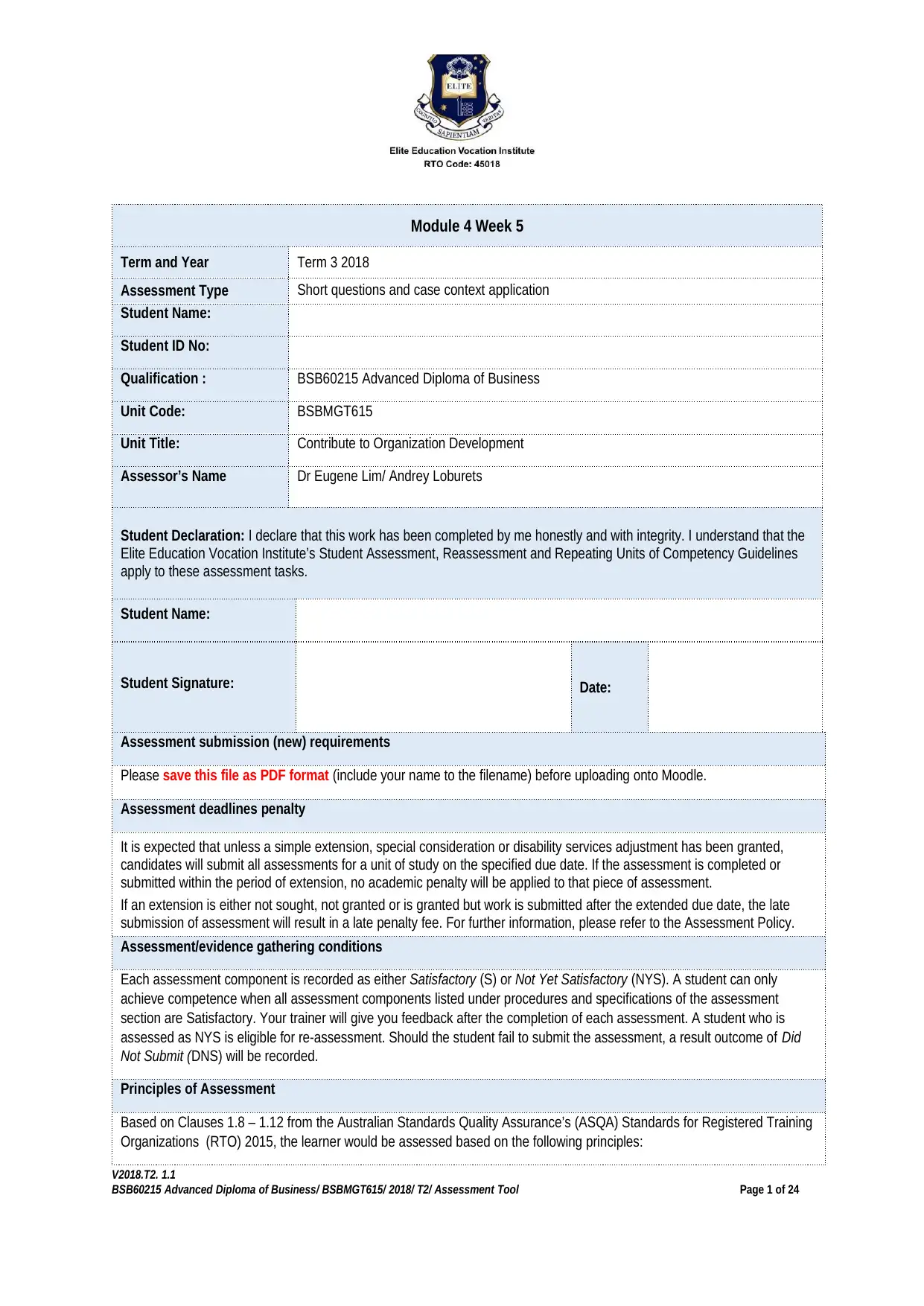
Module 4 Week 5
Term and Year Term 3 2018
Assessment Type Short questions and case context application
Student Name:
Student ID No:
Qualification : BSB60215 Advanced Diploma of Business
Unit Code: BSBMGT615
Unit Title: Contribute to Organization Development
Assessor’s Name Dr Eugene Lim/ Andrey Loburets
Student Declaration: I declare that this work has been completed by me honestly and with integrity. I understand that the
Elite Education Vocation Institute’s Student Assessment, Reassessment and Repeating Units of Competency Guidelines
apply to these assessment tasks.
Student Name:
Student Signature: Date:
Assessment submission (new) requirements
Please save this file as PDF format (include your name to the filename) before uploading onto Moodle.
Assessment deadlines penalty
It is expected that unless a simple extension, special consideration or disability services adjustment has been granted,
candidates will submit all assessments for a unit of study on the specified due date. If the assessment is completed or
submitted within the period of extension, no academic penalty will be applied to that piece of assessment.
If an extension is either not sought, not granted or is granted but work is submitted after the extended due date, the late
submission of assessment will result in a late penalty fee. For further information, please refer to the Assessment Policy.
Assessment/evidence gathering conditions
Each assessment component is recorded as either Satisfactory (S) or Not Yet Satisfactory (NYS). A student can only
achieve competence when all assessment components listed under procedures and specifications of the assessment
section are Satisfactory. Your trainer will give you feedback after the completion of each assessment. A student who is
assessed as NYS is eligible for re-assessment. Should the student fail to submit the assessment, a result outcome of Did
Not Submit (DNS) will be recorded.
Principles of Assessment
Based on Clauses 1.8 – 1.12 from the Australian Standards Quality Assurance’s (ASQA) Standards for Registered Training
Organizations (RTO) 2015, the learner would be assessed based on the following principles:
V2018.T2. 1.1
BSB60215 Advanced Diploma of Business/ BSBMGT615/ 2018/ T2/ Assessment Tool Page 1 of 24
Term and Year Term 3 2018
Assessment Type Short questions and case context application
Student Name:
Student ID No:
Qualification : BSB60215 Advanced Diploma of Business
Unit Code: BSBMGT615
Unit Title: Contribute to Organization Development
Assessor’s Name Dr Eugene Lim/ Andrey Loburets
Student Declaration: I declare that this work has been completed by me honestly and with integrity. I understand that the
Elite Education Vocation Institute’s Student Assessment, Reassessment and Repeating Units of Competency Guidelines
apply to these assessment tasks.
Student Name:
Student Signature: Date:
Assessment submission (new) requirements
Please save this file as PDF format (include your name to the filename) before uploading onto Moodle.
Assessment deadlines penalty
It is expected that unless a simple extension, special consideration or disability services adjustment has been granted,
candidates will submit all assessments for a unit of study on the specified due date. If the assessment is completed or
submitted within the period of extension, no academic penalty will be applied to that piece of assessment.
If an extension is either not sought, not granted or is granted but work is submitted after the extended due date, the late
submission of assessment will result in a late penalty fee. For further information, please refer to the Assessment Policy.
Assessment/evidence gathering conditions
Each assessment component is recorded as either Satisfactory (S) or Not Yet Satisfactory (NYS). A student can only
achieve competence when all assessment components listed under procedures and specifications of the assessment
section are Satisfactory. Your trainer will give you feedback after the completion of each assessment. A student who is
assessed as NYS is eligible for re-assessment. Should the student fail to submit the assessment, a result outcome of Did
Not Submit (DNS) will be recorded.
Principles of Assessment
Based on Clauses 1.8 – 1.12 from the Australian Standards Quality Assurance’s (ASQA) Standards for Registered Training
Organizations (RTO) 2015, the learner would be assessed based on the following principles:
V2018.T2. 1.1
BSB60215 Advanced Diploma of Business/ BSBMGT615/ 2018/ T2/ Assessment Tool Page 1 of 24
Paraphrase This Document
Need a fresh take? Get an instant paraphrase of this document with our AI Paraphraser
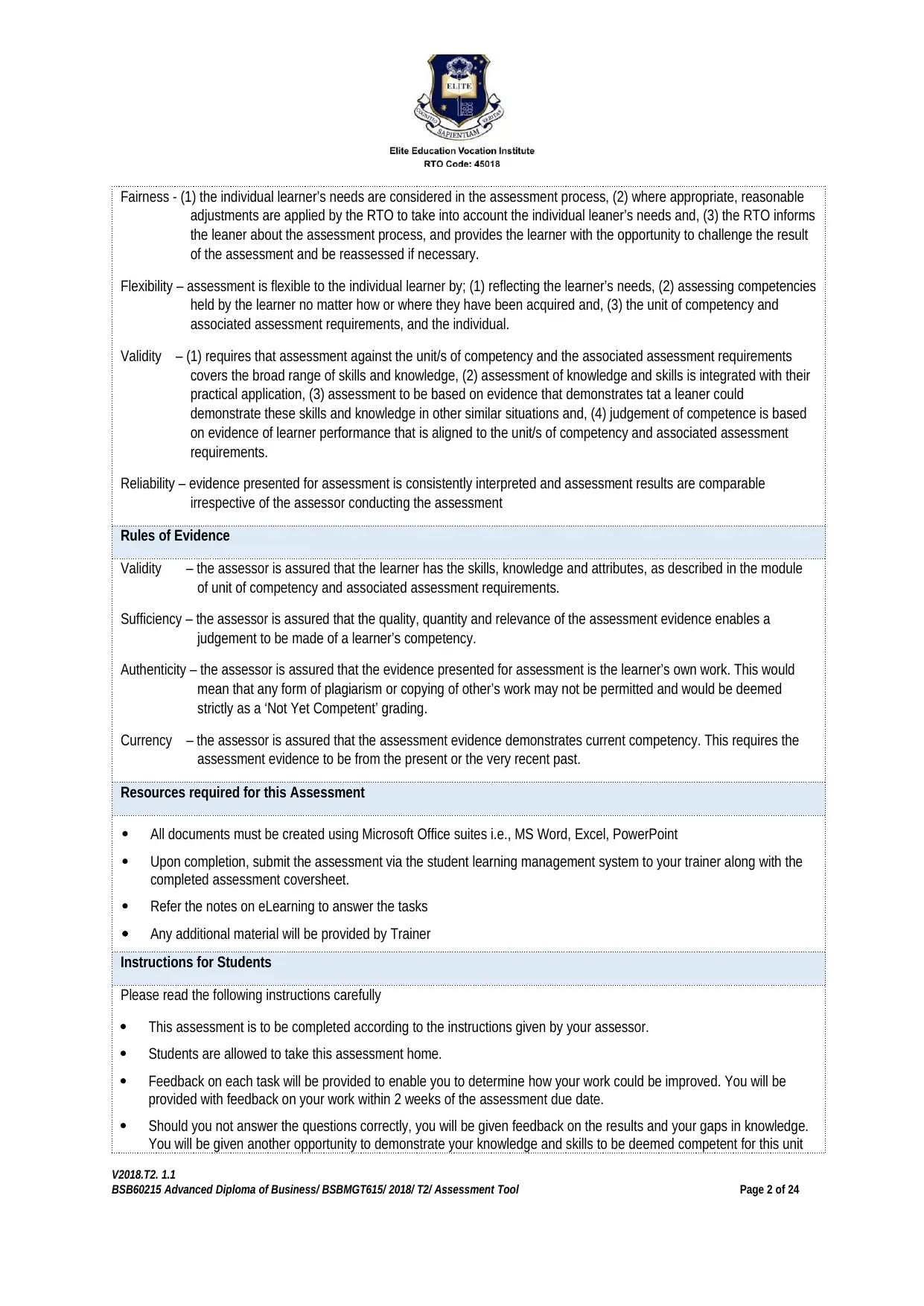
Fairness - (1) the individual learner’s needs are considered in the assessment process, (2) where appropriate, reasonable
adjustments are applied by the RTO to take into account the individual leaner’s needs and, (3) the RTO informs
the leaner about the assessment process, and provides the learner with the opportunity to challenge the result
of the assessment and be reassessed if necessary.
Flexibility – assessment is flexible to the individual learner by; (1) reflecting the learner’s needs, (2) assessing competencies
held by the learner no matter how or where they have been acquired and, (3) the unit of competency and
associated assessment requirements, and the individual.
Validity – (1) requires that assessment against the unit/s of competency and the associated assessment requirements
covers the broad range of skills and knowledge, (2) assessment of knowledge and skills is integrated with their
practical application, (3) assessment to be based on evidence that demonstrates tat a leaner could
demonstrate these skills and knowledge in other similar situations and, (4) judgement of competence is based
on evidence of learner performance that is aligned to the unit/s of competency and associated assessment
requirements.
Reliability – evidence presented for assessment is consistently interpreted and assessment results are comparable
irrespective of the assessor conducting the assessment
Rules of Evidence
Validity – the assessor is assured that the learner has the skills, knowledge and attributes, as described in the module
of unit of competency and associated assessment requirements.
Sufficiency – the assessor is assured that the quality, quantity and relevance of the assessment evidence enables a
judgement to be made of a learner’s competency.
Authenticity – the assessor is assured that the evidence presented for assessment is the learner’s own work. This would
mean that any form of plagiarism or copying of other’s work may not be permitted and would be deemed
strictly as a ‘Not Yet Competent’ grading.
Currency – the assessor is assured that the assessment evidence demonstrates current competency. This requires the
assessment evidence to be from the present or the very recent past.
Resources required for this Assessment
All documents must be created using Microsoft Office suites i.e., MS Word, Excel, PowerPoint
Upon completion, submit the assessment via the student learning management system to your trainer along with the
completed assessment coversheet.
Refer the notes on eLearning to answer the tasks
Any additional material will be provided by Trainer
Instructions for Students
Please read the following instructions carefully
This assessment is to be completed according to the instructions given by your assessor.
Students are allowed to take this assessment home.
Feedback on each task will be provided to enable you to determine how your work could be improved. You will be
provided with feedback on your work within 2 weeks of the assessment due date.
Should you not answer the questions correctly, you will be given feedback on the results and your gaps in knowledge.
You will be given another opportunity to demonstrate your knowledge and skills to be deemed competent for this unit
V2018.T2. 1.1
BSB60215 Advanced Diploma of Business/ BSBMGT615/ 2018/ T2/ Assessment Tool Page 2 of 24
adjustments are applied by the RTO to take into account the individual leaner’s needs and, (3) the RTO informs
the leaner about the assessment process, and provides the learner with the opportunity to challenge the result
of the assessment and be reassessed if necessary.
Flexibility – assessment is flexible to the individual learner by; (1) reflecting the learner’s needs, (2) assessing competencies
held by the learner no matter how or where they have been acquired and, (3) the unit of competency and
associated assessment requirements, and the individual.
Validity – (1) requires that assessment against the unit/s of competency and the associated assessment requirements
covers the broad range of skills and knowledge, (2) assessment of knowledge and skills is integrated with their
practical application, (3) assessment to be based on evidence that demonstrates tat a leaner could
demonstrate these skills and knowledge in other similar situations and, (4) judgement of competence is based
on evidence of learner performance that is aligned to the unit/s of competency and associated assessment
requirements.
Reliability – evidence presented for assessment is consistently interpreted and assessment results are comparable
irrespective of the assessor conducting the assessment
Rules of Evidence
Validity – the assessor is assured that the learner has the skills, knowledge and attributes, as described in the module
of unit of competency and associated assessment requirements.
Sufficiency – the assessor is assured that the quality, quantity and relevance of the assessment evidence enables a
judgement to be made of a learner’s competency.
Authenticity – the assessor is assured that the evidence presented for assessment is the learner’s own work. This would
mean that any form of plagiarism or copying of other’s work may not be permitted and would be deemed
strictly as a ‘Not Yet Competent’ grading.
Currency – the assessor is assured that the assessment evidence demonstrates current competency. This requires the
assessment evidence to be from the present or the very recent past.
Resources required for this Assessment
All documents must be created using Microsoft Office suites i.e., MS Word, Excel, PowerPoint
Upon completion, submit the assessment via the student learning management system to your trainer along with the
completed assessment coversheet.
Refer the notes on eLearning to answer the tasks
Any additional material will be provided by Trainer
Instructions for Students
Please read the following instructions carefully
This assessment is to be completed according to the instructions given by your assessor.
Students are allowed to take this assessment home.
Feedback on each task will be provided to enable you to determine how your work could be improved. You will be
provided with feedback on your work within 2 weeks of the assessment due date.
Should you not answer the questions correctly, you will be given feedback on the results and your gaps in knowledge.
You will be given another opportunity to demonstrate your knowledge and skills to be deemed competent for this unit
V2018.T2. 1.1
BSB60215 Advanced Diploma of Business/ BSBMGT615/ 2018/ T2/ Assessment Tool Page 2 of 24
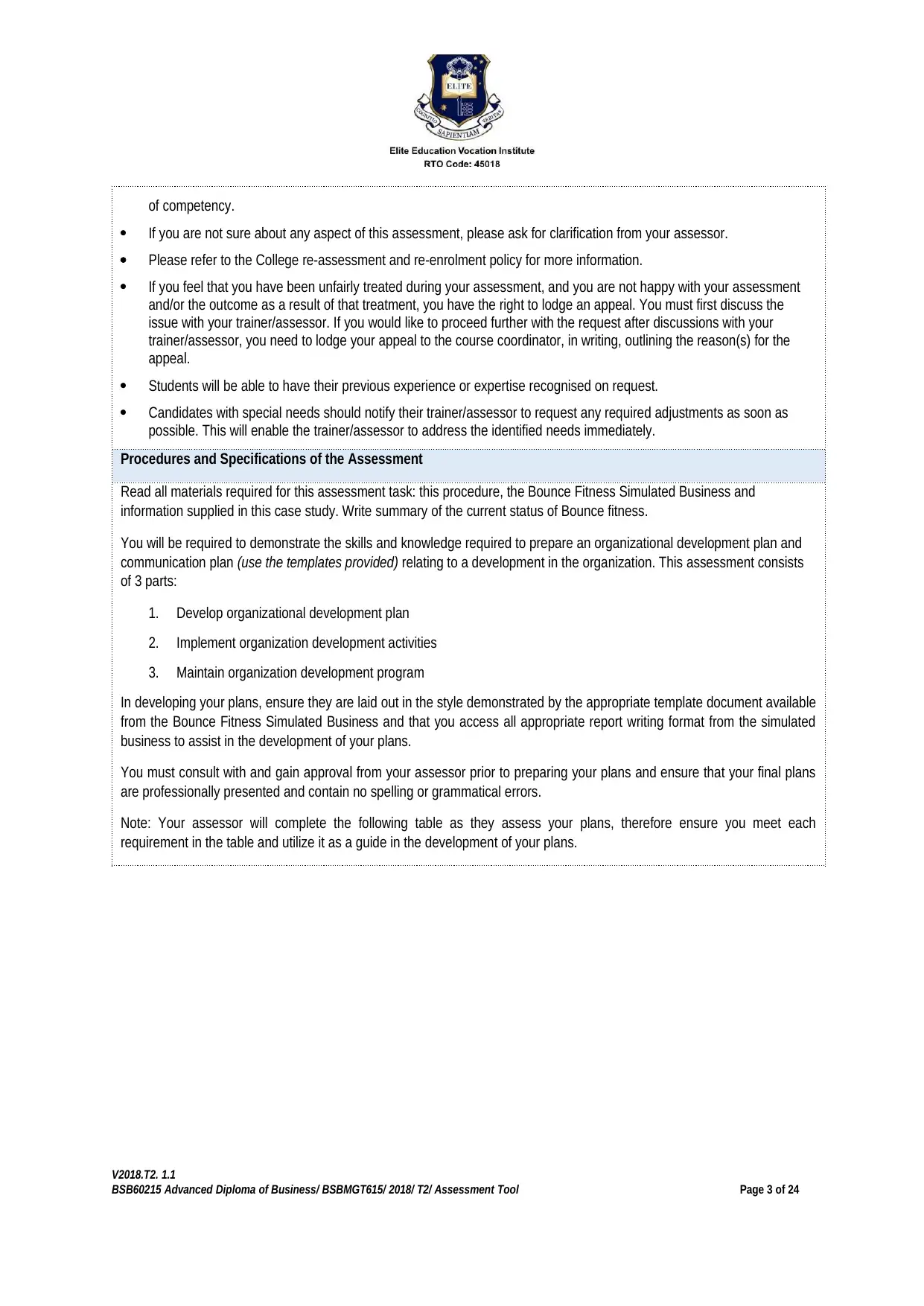
of competency.
If you are not sure about any aspect of this assessment, please ask for clarification from your assessor.
Please refer to the College re-assessment and re-enrolment policy for more information.
If you feel that you have been unfairly treated during your assessment, and you are not happy with your assessment
and/or the outcome as a result of that treatment, you have the right to lodge an appeal. You must first discuss the
issue with your trainer/assessor. If you would like to proceed further with the request after discussions with your
trainer/assessor, you need to lodge your appeal to the course coordinator, in writing, outlining the reason(s) for the
appeal.
Students will be able to have their previous experience or expertise recognised on request.
Candidates with special needs should notify their trainer/assessor to request any required adjustments as soon as
possible. This will enable the trainer/assessor to address the identified needs immediately.
Procedures and Specifications of the Assessment
Read all materials required for this assessment task: this procedure, the Bounce Fitness Simulated Business and
information supplied in this case study. Write summary of the current status of Bounce fitness.
You will be required to demonstrate the skills and knowledge required to prepare an organizational development plan and
communication plan (use the templates provided) relating to a development in the organization. This assessment consists
of 3 parts:
1. Develop organizational development plan
2. Implement organization development activities
3. Maintain organization development program
In developing your plans, ensure they are laid out in the style demonstrated by the appropriate template document available
from the Bounce Fitness Simulated Business and that you access all appropriate report writing format from the simulated
business to assist in the development of your plans.
You must consult with and gain approval from your assessor prior to preparing your plans and ensure that your final plans
are professionally presented and contain no spelling or grammatical errors.
Note: Your assessor will complete the following table as they assess your plans, therefore ensure you meet each
requirement in the table and utilize it as a guide in the development of your plans.
V2018.T2. 1.1
BSB60215 Advanced Diploma of Business/ BSBMGT615/ 2018/ T2/ Assessment Tool Page 3 of 24
If you are not sure about any aspect of this assessment, please ask for clarification from your assessor.
Please refer to the College re-assessment and re-enrolment policy for more information.
If you feel that you have been unfairly treated during your assessment, and you are not happy with your assessment
and/or the outcome as a result of that treatment, you have the right to lodge an appeal. You must first discuss the
issue with your trainer/assessor. If you would like to proceed further with the request after discussions with your
trainer/assessor, you need to lodge your appeal to the course coordinator, in writing, outlining the reason(s) for the
appeal.
Students will be able to have their previous experience or expertise recognised on request.
Candidates with special needs should notify their trainer/assessor to request any required adjustments as soon as
possible. This will enable the trainer/assessor to address the identified needs immediately.
Procedures and Specifications of the Assessment
Read all materials required for this assessment task: this procedure, the Bounce Fitness Simulated Business and
information supplied in this case study. Write summary of the current status of Bounce fitness.
You will be required to demonstrate the skills and knowledge required to prepare an organizational development plan and
communication plan (use the templates provided) relating to a development in the organization. This assessment consists
of 3 parts:
1. Develop organizational development plan
2. Implement organization development activities
3. Maintain organization development program
In developing your plans, ensure they are laid out in the style demonstrated by the appropriate template document available
from the Bounce Fitness Simulated Business and that you access all appropriate report writing format from the simulated
business to assist in the development of your plans.
You must consult with and gain approval from your assessor prior to preparing your plans and ensure that your final plans
are professionally presented and contain no spelling or grammatical errors.
Note: Your assessor will complete the following table as they assess your plans, therefore ensure you meet each
requirement in the table and utilize it as a guide in the development of your plans.
V2018.T2. 1.1
BSB60215 Advanced Diploma of Business/ BSBMGT615/ 2018/ T2/ Assessment Tool Page 3 of 24
⊘ This is a preview!⊘
Do you want full access?
Subscribe today to unlock all pages.

Trusted by 1+ million students worldwide
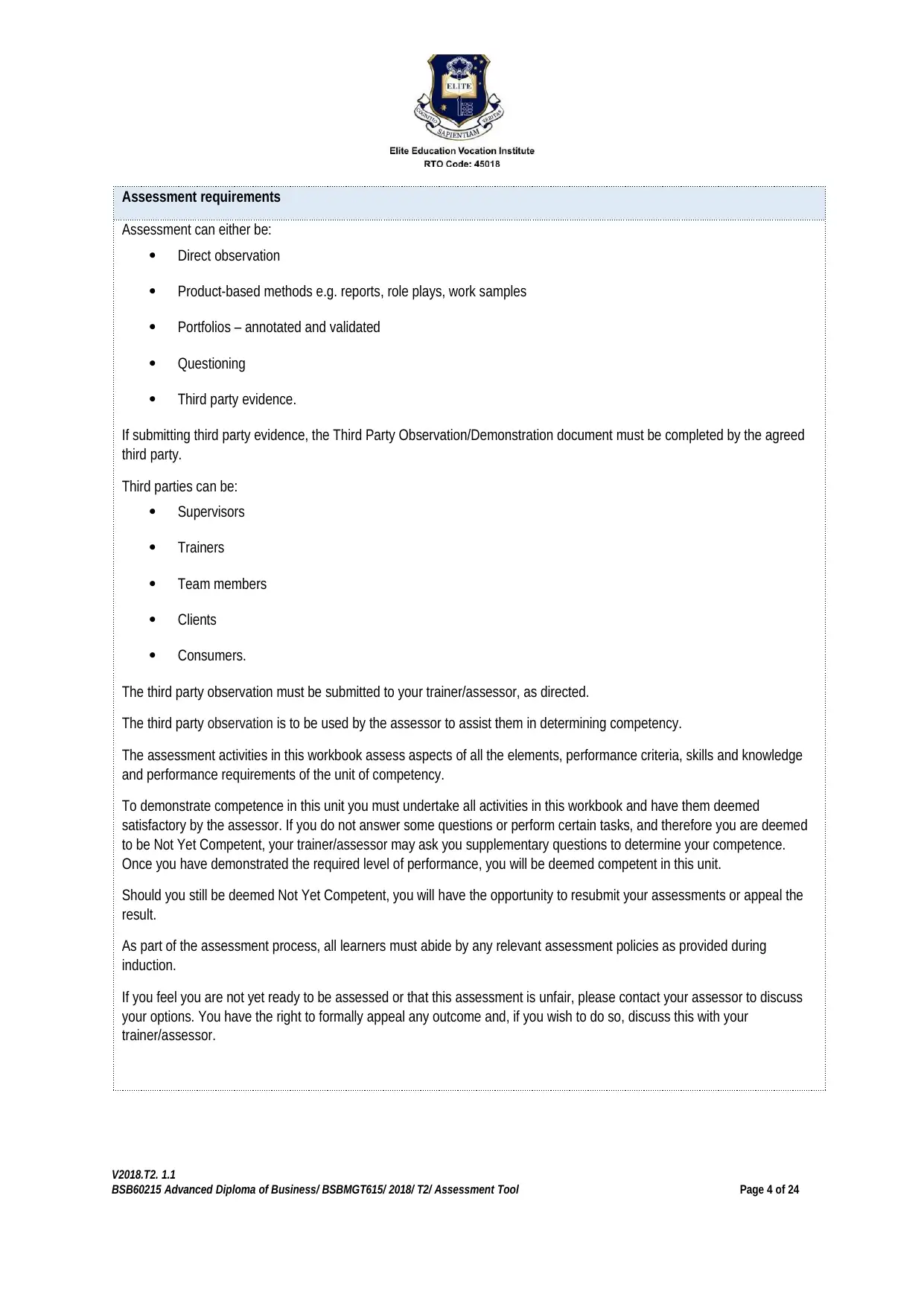
Assessment requirements
Assessment can either be:
Direct observation
Product-based methods e.g. reports, role plays, work samples
Portfolios – annotated and validated
Questioning
Third party evidence.
If submitting third party evidence, the Third Party Observation/Demonstration document must be completed by the agreed
third party.
Third parties can be:
Supervisors
Trainers
Team members
Clients
Consumers.
The third party observation must be submitted to your trainer/assessor, as directed.
The third party observation is to be used by the assessor to assist them in determining competency.
The assessment activities in this workbook assess aspects of all the elements, performance criteria, skills and knowledge
and performance requirements of the unit of competency.
To demonstrate competence in this unit you must undertake all activities in this workbook and have them deemed
satisfactory by the assessor. If you do not answer some questions or perform certain tasks, and therefore you are deemed
to be Not Yet Competent, your trainer/assessor may ask you supplementary questions to determine your competence.
Once you have demonstrated the required level of performance, you will be deemed competent in this unit.
Should you still be deemed Not Yet Competent, you will have the opportunity to resubmit your assessments or appeal the
result.
As part of the assessment process, all learners must abide by any relevant assessment policies as provided during
induction.
If you feel you are not yet ready to be assessed or that this assessment is unfair, please contact your assessor to discuss
your options. You have the right to formally appeal any outcome and, if you wish to do so, discuss this with your
trainer/assessor.
V2018.T2. 1.1
BSB60215 Advanced Diploma of Business/ BSBMGT615/ 2018/ T2/ Assessment Tool Page 4 of 24
Assessment can either be:
Direct observation
Product-based methods e.g. reports, role plays, work samples
Portfolios – annotated and validated
Questioning
Third party evidence.
If submitting third party evidence, the Third Party Observation/Demonstration document must be completed by the agreed
third party.
Third parties can be:
Supervisors
Trainers
Team members
Clients
Consumers.
The third party observation must be submitted to your trainer/assessor, as directed.
The third party observation is to be used by the assessor to assist them in determining competency.
The assessment activities in this workbook assess aspects of all the elements, performance criteria, skills and knowledge
and performance requirements of the unit of competency.
To demonstrate competence in this unit you must undertake all activities in this workbook and have them deemed
satisfactory by the assessor. If you do not answer some questions or perform certain tasks, and therefore you are deemed
to be Not Yet Competent, your trainer/assessor may ask you supplementary questions to determine your competence.
Once you have demonstrated the required level of performance, you will be deemed competent in this unit.
Should you still be deemed Not Yet Competent, you will have the opportunity to resubmit your assessments or appeal the
result.
As part of the assessment process, all learners must abide by any relevant assessment policies as provided during
induction.
If you feel you are not yet ready to be assessed or that this assessment is unfair, please contact your assessor to discuss
your options. You have the right to formally appeal any outcome and, if you wish to do so, discuss this with your
trainer/assessor.
V2018.T2. 1.1
BSB60215 Advanced Diploma of Business/ BSBMGT615/ 2018/ T2/ Assessment Tool Page 4 of 24
Paraphrase This Document
Need a fresh take? Get an instant paraphrase of this document with our AI Paraphraser
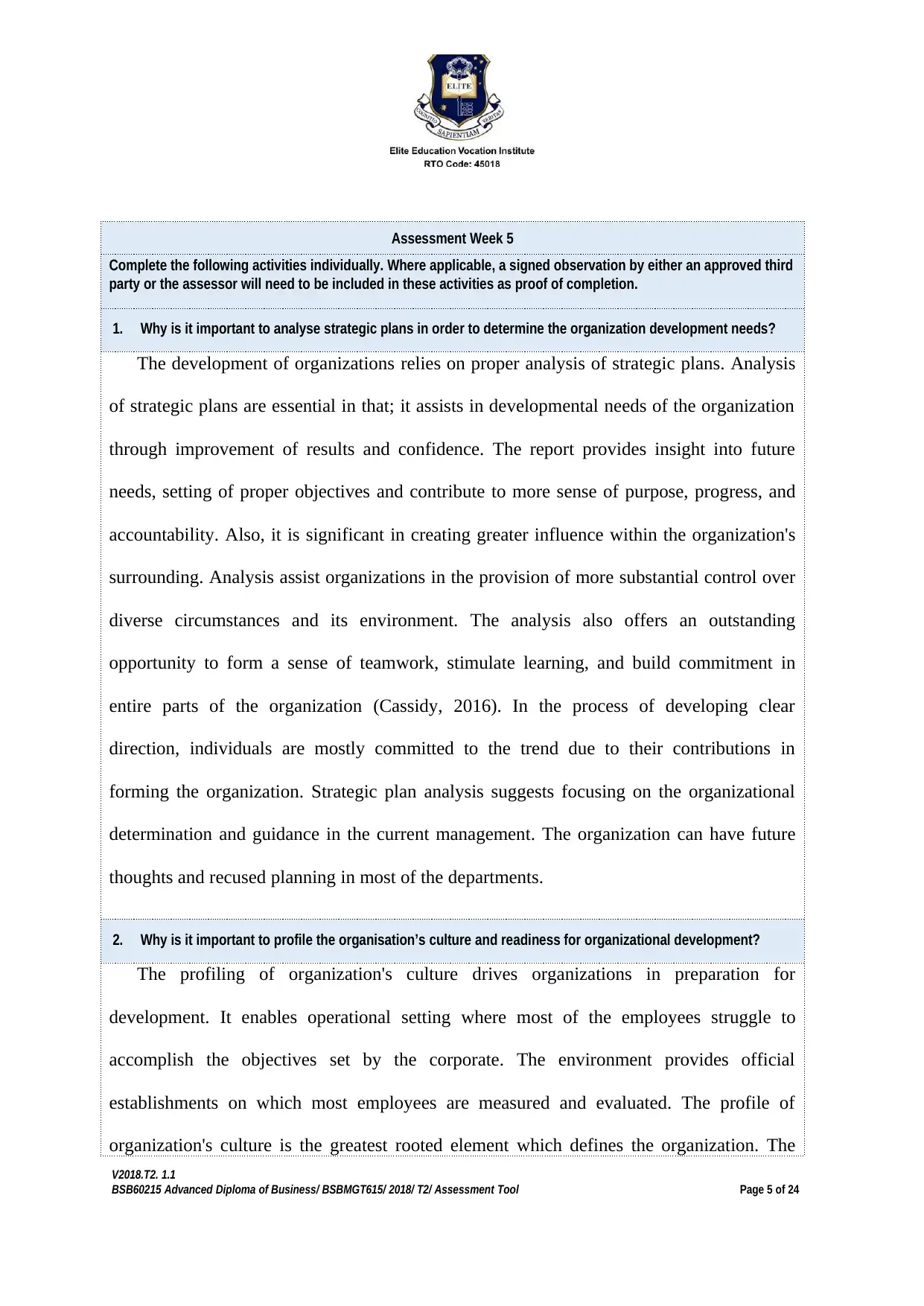
Assessment Week 5
Complete the following activities individually. Where applicable, a signed observation by either an approved third
party or the assessor will need to be included in these activities as proof of completion.
1. Why is it important to analyse strategic plans in order to determine the organization development needs?
The development of organizations relies on proper analysis of strategic plans. Analysis
of strategic plans are essential in that; it assists in developmental needs of the organization
through improvement of results and confidence. The report provides insight into future
needs, setting of proper objectives and contribute to more sense of purpose, progress, and
accountability. Also, it is significant in creating greater influence within the organization's
surrounding. Analysis assist organizations in the provision of more substantial control over
diverse circumstances and its environment. The analysis also offers an outstanding
opportunity to form a sense of teamwork, stimulate learning, and build commitment in
entire parts of the organization (Cassidy, 2016). In the process of developing clear
direction, individuals are mostly committed to the trend due to their contributions in
forming the organization. Strategic plan analysis suggests focusing on the organizational
determination and guidance in the current management. The organization can have future
thoughts and recused planning in most of the departments.
2. Why is it important to profile the organisation’s culture and readiness for organizational development?
The profiling of organization's culture drives organizations in preparation for
development. It enables operational setting where most of the employees struggle to
accomplish the objectives set by the corporate. The environment provides official
establishments on which most employees are measured and evaluated. The profile of
organization's culture is the greatest rooted element which defines the organization. The
V2018.T2. 1.1
BSB60215 Advanced Diploma of Business/ BSBMGT615/ 2018/ T2/ Assessment Tool Page 5 of 24
Complete the following activities individually. Where applicable, a signed observation by either an approved third
party or the assessor will need to be included in these activities as proof of completion.
1. Why is it important to analyse strategic plans in order to determine the organization development needs?
The development of organizations relies on proper analysis of strategic plans. Analysis
of strategic plans are essential in that; it assists in developmental needs of the organization
through improvement of results and confidence. The report provides insight into future
needs, setting of proper objectives and contribute to more sense of purpose, progress, and
accountability. Also, it is significant in creating greater influence within the organization's
surrounding. Analysis assist organizations in the provision of more substantial control over
diverse circumstances and its environment. The analysis also offers an outstanding
opportunity to form a sense of teamwork, stimulate learning, and build commitment in
entire parts of the organization (Cassidy, 2016). In the process of developing clear
direction, individuals are mostly committed to the trend due to their contributions in
forming the organization. Strategic plan analysis suggests focusing on the organizational
determination and guidance in the current management. The organization can have future
thoughts and recused planning in most of the departments.
2. Why is it important to profile the organisation’s culture and readiness for organizational development?
The profiling of organization's culture drives organizations in preparation for
development. It enables operational setting where most of the employees struggle to
accomplish the objectives set by the corporate. The environment provides official
establishments on which most employees are measured and evaluated. The profile of
organization's culture is the greatest rooted element which defines the organization. The
V2018.T2. 1.1
BSB60215 Advanced Diploma of Business/ BSBMGT615/ 2018/ T2/ Assessment Tool Page 5 of 24
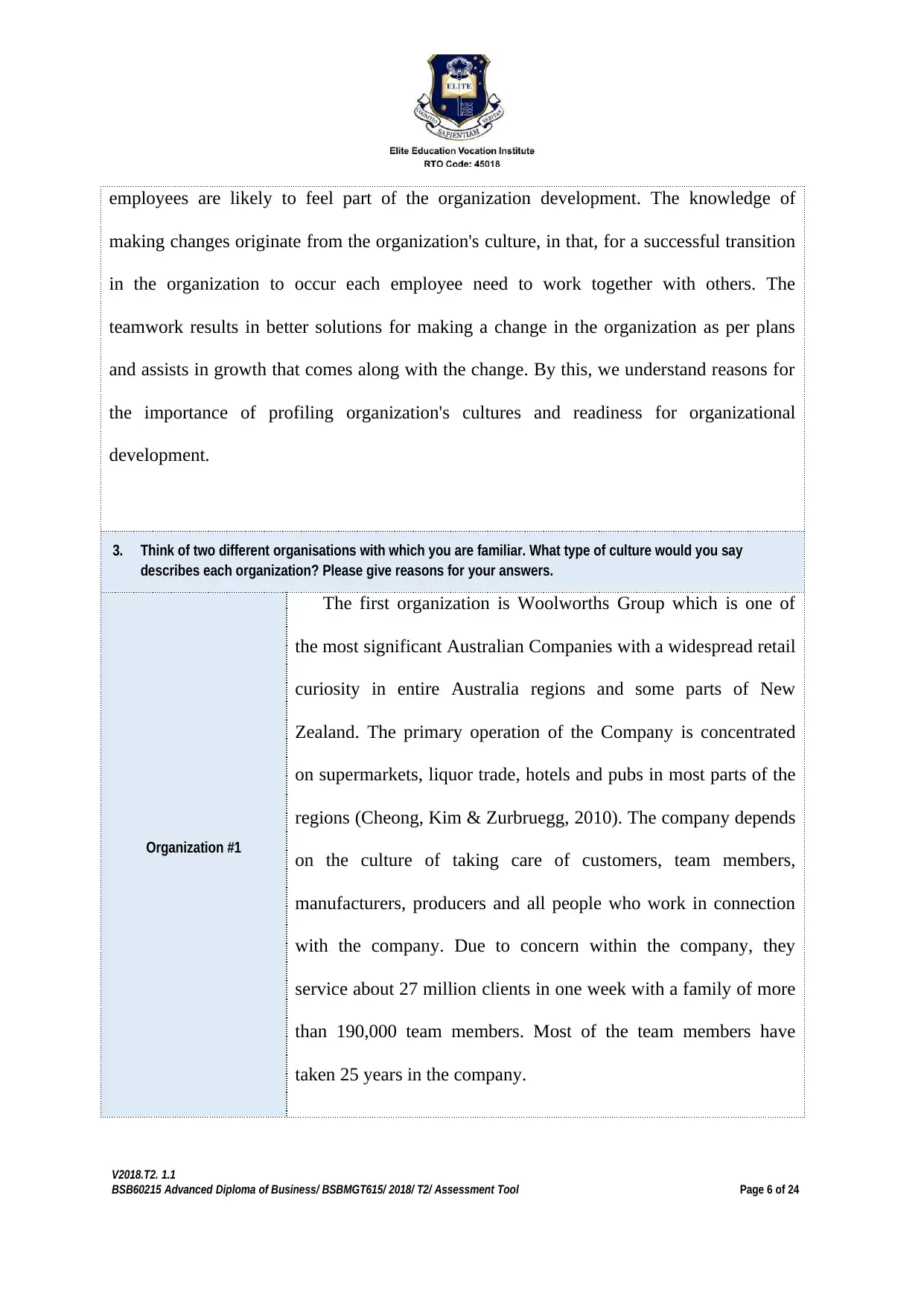
employees are likely to feel part of the organization development. The knowledge of
making changes originate from the organization's culture, in that, for a successful transition
in the organization to occur each employee need to work together with others. The
teamwork results in better solutions for making a change in the organization as per plans
and assists in growth that comes along with the change. By this, we understand reasons for
the importance of profiling organization's cultures and readiness for organizational
development.
3. Think of two different organisations with which you are familiar. What type of culture would you say
describes each organization? Please give reasons for your answers.
Organization #1
The first organization is Woolworths Group which is one of
the most significant Australian Companies with a widespread retail
curiosity in entire Australia regions and some parts of New
Zealand. The primary operation of the Company is concentrated
on supermarkets, liquor trade, hotels and pubs in most parts of the
regions (Cheong, Kim & Zurbruegg, 2010). The company depends
on the culture of taking care of customers, team members,
manufacturers, producers and all people who work in connection
with the company. Due to concern within the company, they
service about 27 million clients in one week with a family of more
than 190,000 team members. Most of the team members have
taken 25 years in the company.
V2018.T2. 1.1
BSB60215 Advanced Diploma of Business/ BSBMGT615/ 2018/ T2/ Assessment Tool Page 6 of 24
making changes originate from the organization's culture, in that, for a successful transition
in the organization to occur each employee need to work together with others. The
teamwork results in better solutions for making a change in the organization as per plans
and assists in growth that comes along with the change. By this, we understand reasons for
the importance of profiling organization's cultures and readiness for organizational
development.
3. Think of two different organisations with which you are familiar. What type of culture would you say
describes each organization? Please give reasons for your answers.
Organization #1
The first organization is Woolworths Group which is one of
the most significant Australian Companies with a widespread retail
curiosity in entire Australia regions and some parts of New
Zealand. The primary operation of the Company is concentrated
on supermarkets, liquor trade, hotels and pubs in most parts of the
regions (Cheong, Kim & Zurbruegg, 2010). The company depends
on the culture of taking care of customers, team members,
manufacturers, producers and all people who work in connection
with the company. Due to concern within the company, they
service about 27 million clients in one week with a family of more
than 190,000 team members. Most of the team members have
taken 25 years in the company.
V2018.T2. 1.1
BSB60215 Advanced Diploma of Business/ BSBMGT615/ 2018/ T2/ Assessment Tool Page 6 of 24
⊘ This is a preview!⊘
Do you want full access?
Subscribe today to unlock all pages.

Trusted by 1+ million students worldwide
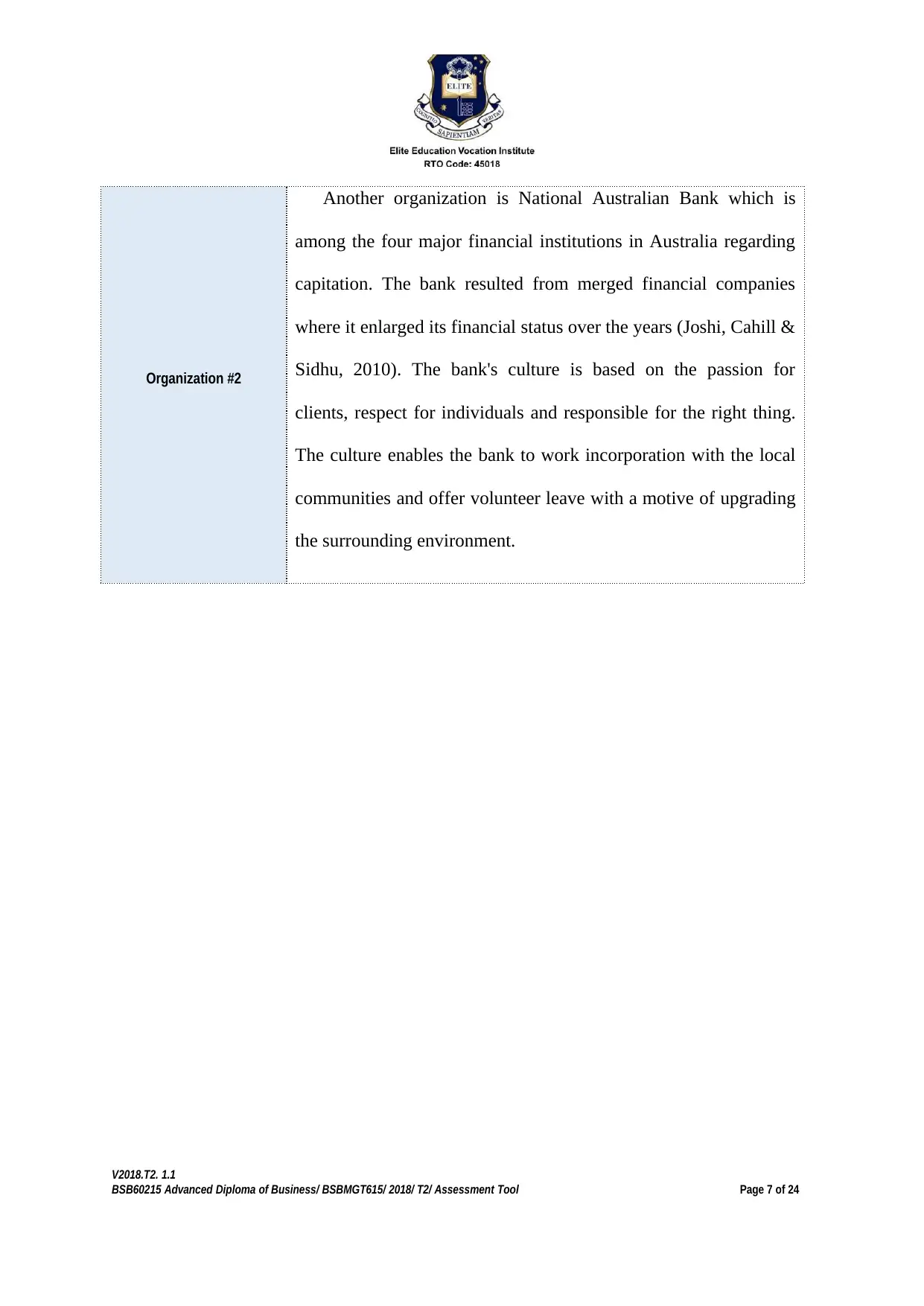
Organization #2
Another organization is National Australian Bank which is
among the four major financial institutions in Australia regarding
capitation. The bank resulted from merged financial companies
where it enlarged its financial status over the years (Joshi, Cahill &
Sidhu, 2010). The bank's culture is based on the passion for
clients, respect for individuals and responsible for the right thing.
The culture enables the bank to work incorporation with the local
communities and offer volunteer leave with a motive of upgrading
the surrounding environment.
V2018.T2. 1.1
BSB60215 Advanced Diploma of Business/ BSBMGT615/ 2018/ T2/ Assessment Tool Page 7 of 24
Another organization is National Australian Bank which is
among the four major financial institutions in Australia regarding
capitation. The bank resulted from merged financial companies
where it enlarged its financial status over the years (Joshi, Cahill &
Sidhu, 2010). The bank's culture is based on the passion for
clients, respect for individuals and responsible for the right thing.
The culture enables the bank to work incorporation with the local
communities and offer volunteer leave with a motive of upgrading
the surrounding environment.
V2018.T2. 1.1
BSB60215 Advanced Diploma of Business/ BSBMGT615/ 2018/ T2/ Assessment Tool Page 7 of 24
Paraphrase This Document
Need a fresh take? Get an instant paraphrase of this document with our AI Paraphraser
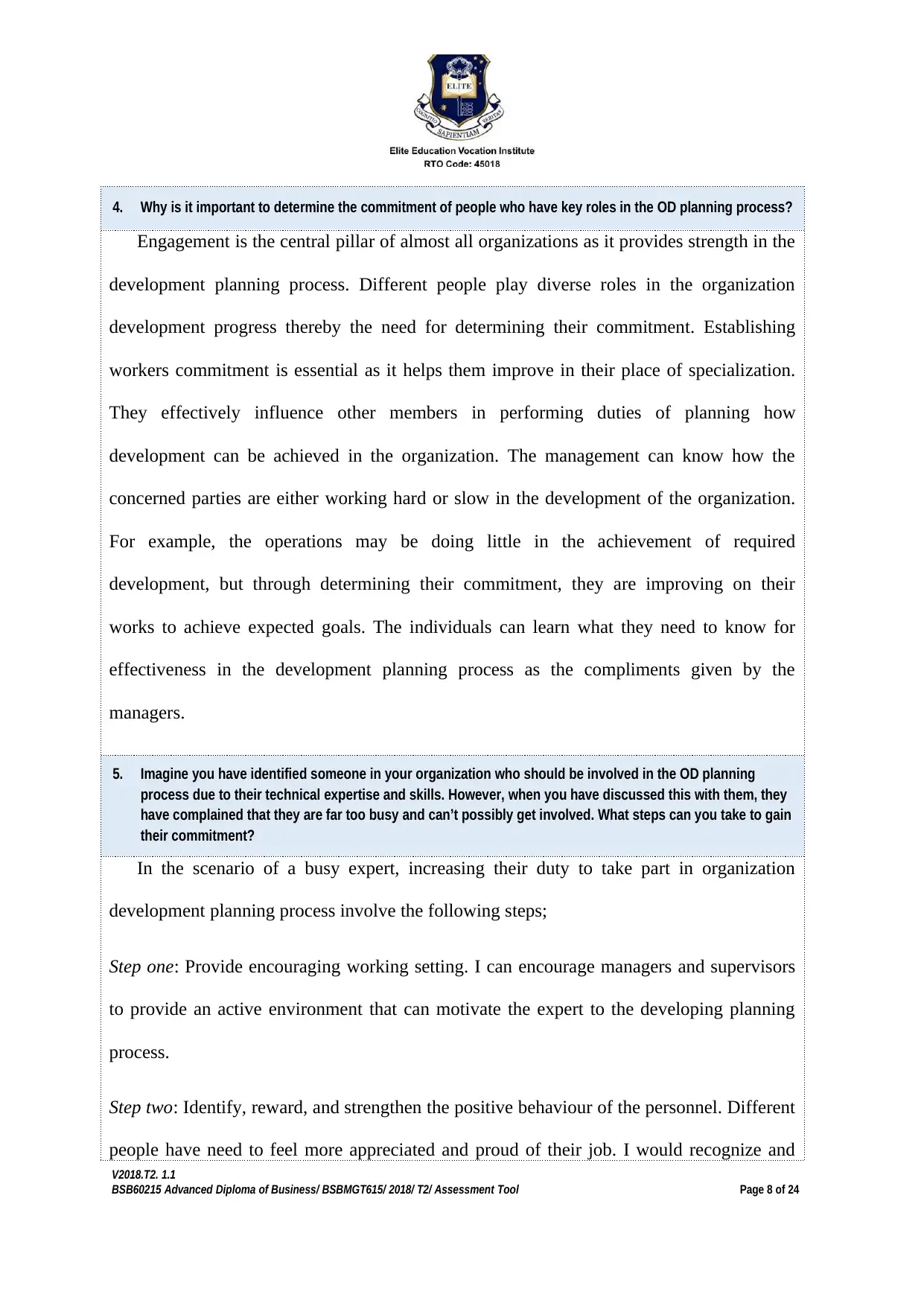
4. Why is it important to determine the commitment of people who have key roles in the OD planning process?
Engagement is the central pillar of almost all organizations as it provides strength in the
development planning process. Different people play diverse roles in the organization
development progress thereby the need for determining their commitment. Establishing
workers commitment is essential as it helps them improve in their place of specialization.
They effectively influence other members in performing duties of planning how
development can be achieved in the organization. The management can know how the
concerned parties are either working hard or slow in the development of the organization.
For example, the operations may be doing little in the achievement of required
development, but through determining their commitment, they are improving on their
works to achieve expected goals. The individuals can learn what they need to know for
effectiveness in the development planning process as the compliments given by the
managers.
5. Imagine you have identified someone in your organization who should be involved in the OD planning
process due to their technical expertise and skills. However, when you have discussed this with them, they
have complained that they are far too busy and can’t possibly get involved. What steps can you take to gain
their commitment?
In the scenario of a busy expert, increasing their duty to take part in organization
development planning process involve the following steps;
Step one: Provide encouraging working setting. I can encourage managers and supervisors
to provide an active environment that can motivate the expert to the developing planning
process.
Step two: Identify, reward, and strengthen the positive behaviour of the personnel. Different
people have need to feel more appreciated and proud of their job. I would recognize and
V2018.T2. 1.1
BSB60215 Advanced Diploma of Business/ BSBMGT615/ 2018/ T2/ Assessment Tool Page 8 of 24
Engagement is the central pillar of almost all organizations as it provides strength in the
development planning process. Different people play diverse roles in the organization
development progress thereby the need for determining their commitment. Establishing
workers commitment is essential as it helps them improve in their place of specialization.
They effectively influence other members in performing duties of planning how
development can be achieved in the organization. The management can know how the
concerned parties are either working hard or slow in the development of the organization.
For example, the operations may be doing little in the achievement of required
development, but through determining their commitment, they are improving on their
works to achieve expected goals. The individuals can learn what they need to know for
effectiveness in the development planning process as the compliments given by the
managers.
5. Imagine you have identified someone in your organization who should be involved in the OD planning
process due to their technical expertise and skills. However, when you have discussed this with them, they
have complained that they are far too busy and can’t possibly get involved. What steps can you take to gain
their commitment?
In the scenario of a busy expert, increasing their duty to take part in organization
development planning process involve the following steps;
Step one: Provide encouraging working setting. I can encourage managers and supervisors
to provide an active environment that can motivate the expert to the developing planning
process.
Step two: Identify, reward, and strengthen the positive behaviour of the personnel. Different
people have need to feel more appreciated and proud of their job. I would recognize and
V2018.T2. 1.1
BSB60215 Advanced Diploma of Business/ BSBMGT615/ 2018/ T2/ Assessment Tool Page 8 of 24
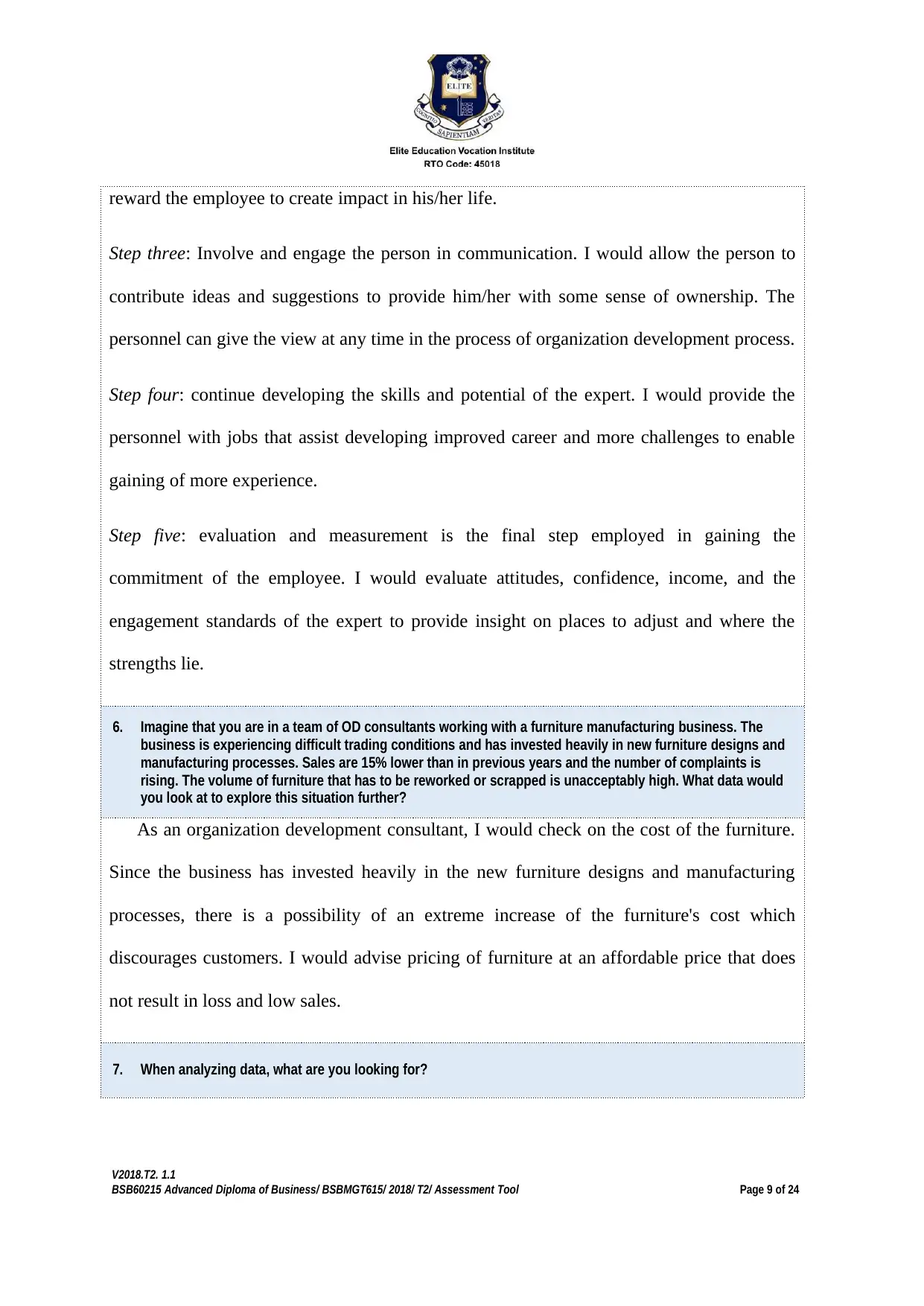
reward the employee to create impact in his/her life.
Step three: Involve and engage the person in communication. I would allow the person to
contribute ideas and suggestions to provide him/her with some sense of ownership. The
personnel can give the view at any time in the process of organization development process.
Step four: continue developing the skills and potential of the expert. I would provide the
personnel with jobs that assist developing improved career and more challenges to enable
gaining of more experience.
Step five: evaluation and measurement is the final step employed in gaining the
commitment of the employee. I would evaluate attitudes, confidence, income, and the
engagement standards of the expert to provide insight on places to adjust and where the
strengths lie.
6. Imagine that you are in a team of OD consultants working with a furniture manufacturing business. The
business is experiencing difficult trading conditions and has invested heavily in new furniture designs and
manufacturing processes. Sales are 15% lower than in previous years and the number of complaints is
rising. The volume of furniture that has to be reworked or scrapped is unacceptably high. What data would
you look at to explore this situation further?
As an organization development consultant, I would check on the cost of the furniture.
Since the business has invested heavily in the new furniture designs and manufacturing
processes, there is a possibility of an extreme increase of the furniture's cost which
discourages customers. I would advise pricing of furniture at an affordable price that does
not result in loss and low sales.
7. When analyzing data, what are you looking for?
V2018.T2. 1.1
BSB60215 Advanced Diploma of Business/ BSBMGT615/ 2018/ T2/ Assessment Tool Page 9 of 24
Step three: Involve and engage the person in communication. I would allow the person to
contribute ideas and suggestions to provide him/her with some sense of ownership. The
personnel can give the view at any time in the process of organization development process.
Step four: continue developing the skills and potential of the expert. I would provide the
personnel with jobs that assist developing improved career and more challenges to enable
gaining of more experience.
Step five: evaluation and measurement is the final step employed in gaining the
commitment of the employee. I would evaluate attitudes, confidence, income, and the
engagement standards of the expert to provide insight on places to adjust and where the
strengths lie.
6. Imagine that you are in a team of OD consultants working with a furniture manufacturing business. The
business is experiencing difficult trading conditions and has invested heavily in new furniture designs and
manufacturing processes. Sales are 15% lower than in previous years and the number of complaints is
rising. The volume of furniture that has to be reworked or scrapped is unacceptably high. What data would
you look at to explore this situation further?
As an organization development consultant, I would check on the cost of the furniture.
Since the business has invested heavily in the new furniture designs and manufacturing
processes, there is a possibility of an extreme increase of the furniture's cost which
discourages customers. I would advise pricing of furniture at an affordable price that does
not result in loss and low sales.
7. When analyzing data, what are you looking for?
V2018.T2. 1.1
BSB60215 Advanced Diploma of Business/ BSBMGT615/ 2018/ T2/ Assessment Tool Page 9 of 24
⊘ This is a preview!⊘
Do you want full access?
Subscribe today to unlock all pages.

Trusted by 1+ million students worldwide
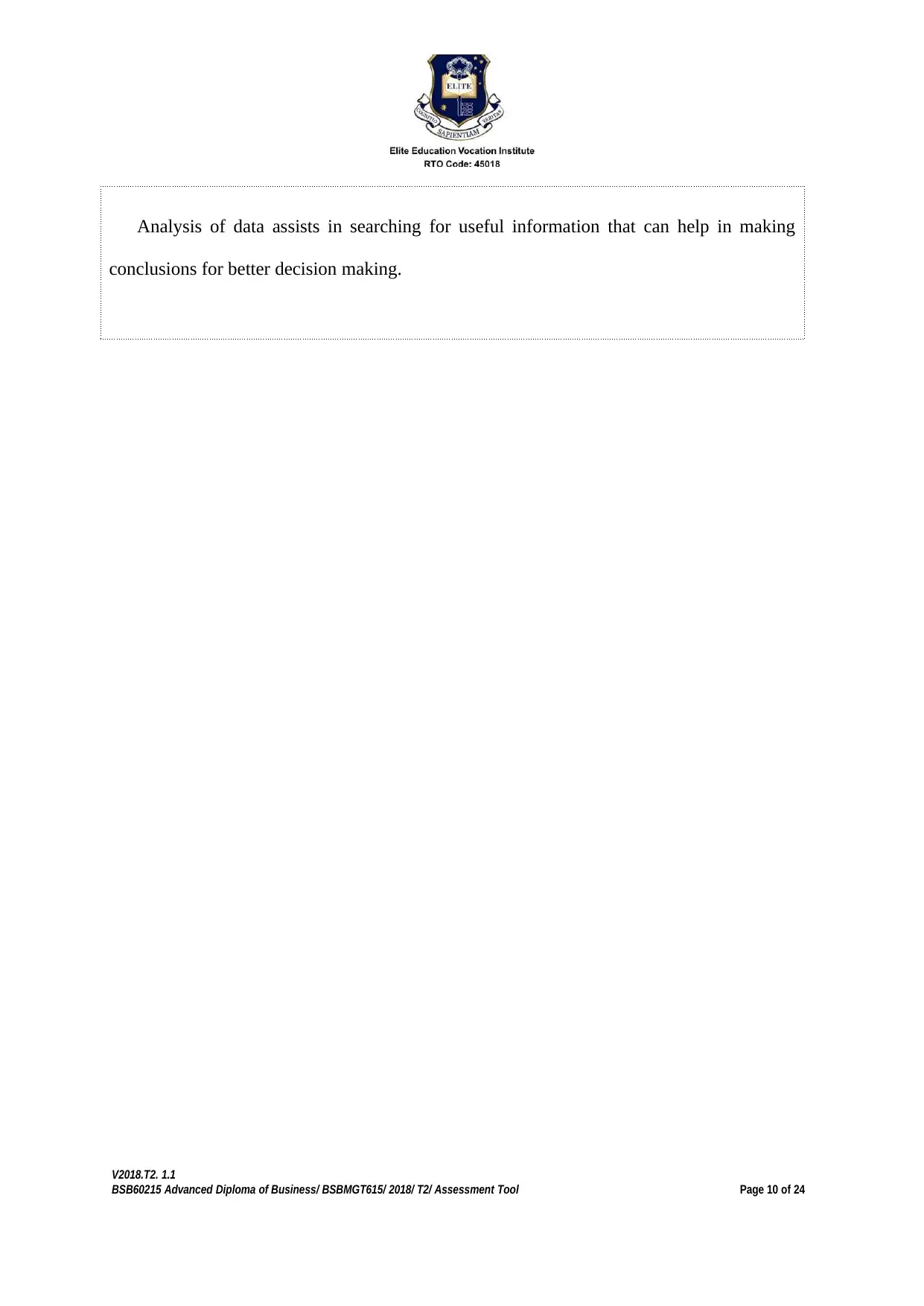
Analysis of data assists in searching for useful information that can help in making
conclusions for better decision making.
V2018.T2. 1.1
BSB60215 Advanced Diploma of Business/ BSBMGT615/ 2018/ T2/ Assessment Tool Page 10 of 24
conclusions for better decision making.
V2018.T2. 1.1
BSB60215 Advanced Diploma of Business/ BSBMGT615/ 2018/ T2/ Assessment Tool Page 10 of 24
Paraphrase This Document
Need a fresh take? Get an instant paraphrase of this document with our AI Paraphraser
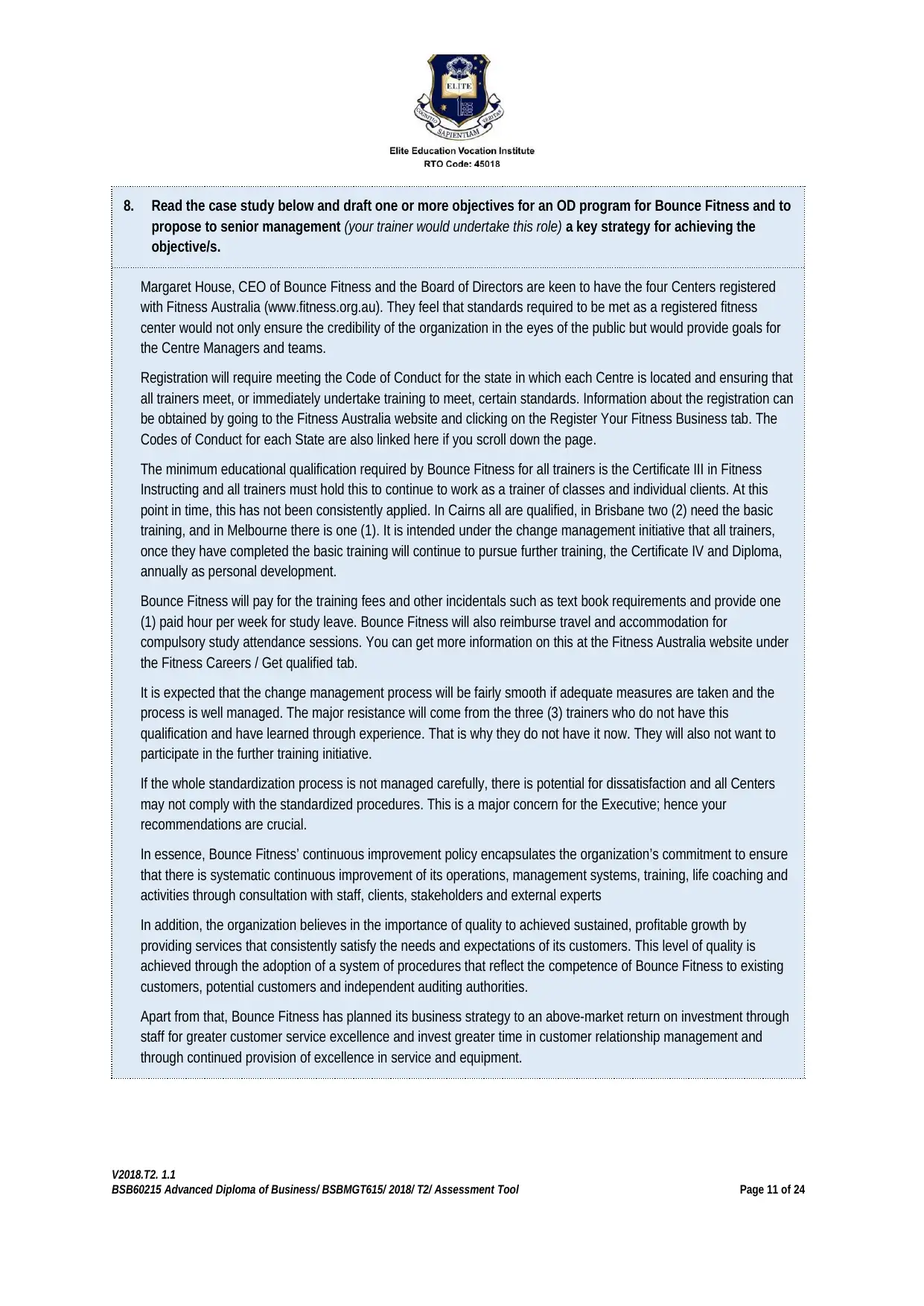
8. Read the case study below and draft one or more objectives for an OD program for Bounce Fitness and to
propose to senior management (your trainer would undertake this role) a key strategy for achieving the
objective/s.
Margaret House, CEO of Bounce Fitness and the Board of Directors are keen to have the four Centers registered
with Fitness Australia (www.fitness.org.au). They feel that standards required to be met as a registered fitness
center would not only ensure the credibility of the organization in the eyes of the public but would provide goals for
the Centre Managers and teams.
Registration will require meeting the Code of Conduct for the state in which each Centre is located and ensuring that
all trainers meet, or immediately undertake training to meet, certain standards. Information about the registration can
be obtained by going to the Fitness Australia website and clicking on the Register Your Fitness Business tab. The
Codes of Conduct for each State are also linked here if you scroll down the page.
The minimum educational qualification required by Bounce Fitness for all trainers is the Certificate III in Fitness
Instructing and all trainers must hold this to continue to work as a trainer of classes and individual clients. At this
point in time, this has not been consistently applied. In Cairns all are qualified, in Brisbane two (2) need the basic
training, and in Melbourne there is one (1). It is intended under the change management initiative that all trainers,
once they have completed the basic training will continue to pursue further training, the Certificate IV and Diploma,
annually as personal development.
Bounce Fitness will pay for the training fees and other incidentals such as text book requirements and provide one
(1) paid hour per week for study leave. Bounce Fitness will also reimburse travel and accommodation for
compulsory study attendance sessions. You can get more information on this at the Fitness Australia website under
the Fitness Careers / Get qualified tab.
It is expected that the change management process will be fairly smooth if adequate measures are taken and the
process is well managed. The major resistance will come from the three (3) trainers who do not have this
qualification and have learned through experience. That is why they do not have it now. They will also not want to
participate in the further training initiative.
If the whole standardization process is not managed carefully, there is potential for dissatisfaction and all Centers
may not comply with the standardized procedures. This is a major concern for the Executive; hence your
recommendations are crucial.
In essence, Bounce Fitness’ continuous improvement policy encapsulates the organization’s commitment to ensure
that there is systematic continuous improvement of its operations, management systems, training, life coaching and
activities through consultation with staff, clients, stakeholders and external experts
In addition, the organization believes in the importance of quality to achieved sustained, profitable growth by
providing services that consistently satisfy the needs and expectations of its customers. This level of quality is
achieved through the adoption of a system of procedures that reflect the competence of Bounce Fitness to existing
customers, potential customers and independent auditing authorities.
Apart from that, Bounce Fitness has planned its business strategy to an above-market return on investment through
staff for greater customer service excellence and invest greater time in customer relationship management and
through continued provision of excellence in service and equipment.
V2018.T2. 1.1
BSB60215 Advanced Diploma of Business/ BSBMGT615/ 2018/ T2/ Assessment Tool Page 11 of 24
propose to senior management (your trainer would undertake this role) a key strategy for achieving the
objective/s.
Margaret House, CEO of Bounce Fitness and the Board of Directors are keen to have the four Centers registered
with Fitness Australia (www.fitness.org.au). They feel that standards required to be met as a registered fitness
center would not only ensure the credibility of the organization in the eyes of the public but would provide goals for
the Centre Managers and teams.
Registration will require meeting the Code of Conduct for the state in which each Centre is located and ensuring that
all trainers meet, or immediately undertake training to meet, certain standards. Information about the registration can
be obtained by going to the Fitness Australia website and clicking on the Register Your Fitness Business tab. The
Codes of Conduct for each State are also linked here if you scroll down the page.
The minimum educational qualification required by Bounce Fitness for all trainers is the Certificate III in Fitness
Instructing and all trainers must hold this to continue to work as a trainer of classes and individual clients. At this
point in time, this has not been consistently applied. In Cairns all are qualified, in Brisbane two (2) need the basic
training, and in Melbourne there is one (1). It is intended under the change management initiative that all trainers,
once they have completed the basic training will continue to pursue further training, the Certificate IV and Diploma,
annually as personal development.
Bounce Fitness will pay for the training fees and other incidentals such as text book requirements and provide one
(1) paid hour per week for study leave. Bounce Fitness will also reimburse travel and accommodation for
compulsory study attendance sessions. You can get more information on this at the Fitness Australia website under
the Fitness Careers / Get qualified tab.
It is expected that the change management process will be fairly smooth if adequate measures are taken and the
process is well managed. The major resistance will come from the three (3) trainers who do not have this
qualification and have learned through experience. That is why they do not have it now. They will also not want to
participate in the further training initiative.
If the whole standardization process is not managed carefully, there is potential for dissatisfaction and all Centers
may not comply with the standardized procedures. This is a major concern for the Executive; hence your
recommendations are crucial.
In essence, Bounce Fitness’ continuous improvement policy encapsulates the organization’s commitment to ensure
that there is systematic continuous improvement of its operations, management systems, training, life coaching and
activities through consultation with staff, clients, stakeholders and external experts
In addition, the organization believes in the importance of quality to achieved sustained, profitable growth by
providing services that consistently satisfy the needs and expectations of its customers. This level of quality is
achieved through the adoption of a system of procedures that reflect the competence of Bounce Fitness to existing
customers, potential customers and independent auditing authorities.
Apart from that, Bounce Fitness has planned its business strategy to an above-market return on investment through
staff for greater customer service excellence and invest greater time in customer relationship management and
through continued provision of excellence in service and equipment.
V2018.T2. 1.1
BSB60215 Advanced Diploma of Business/ BSBMGT615/ 2018/ T2/ Assessment Tool Page 11 of 24
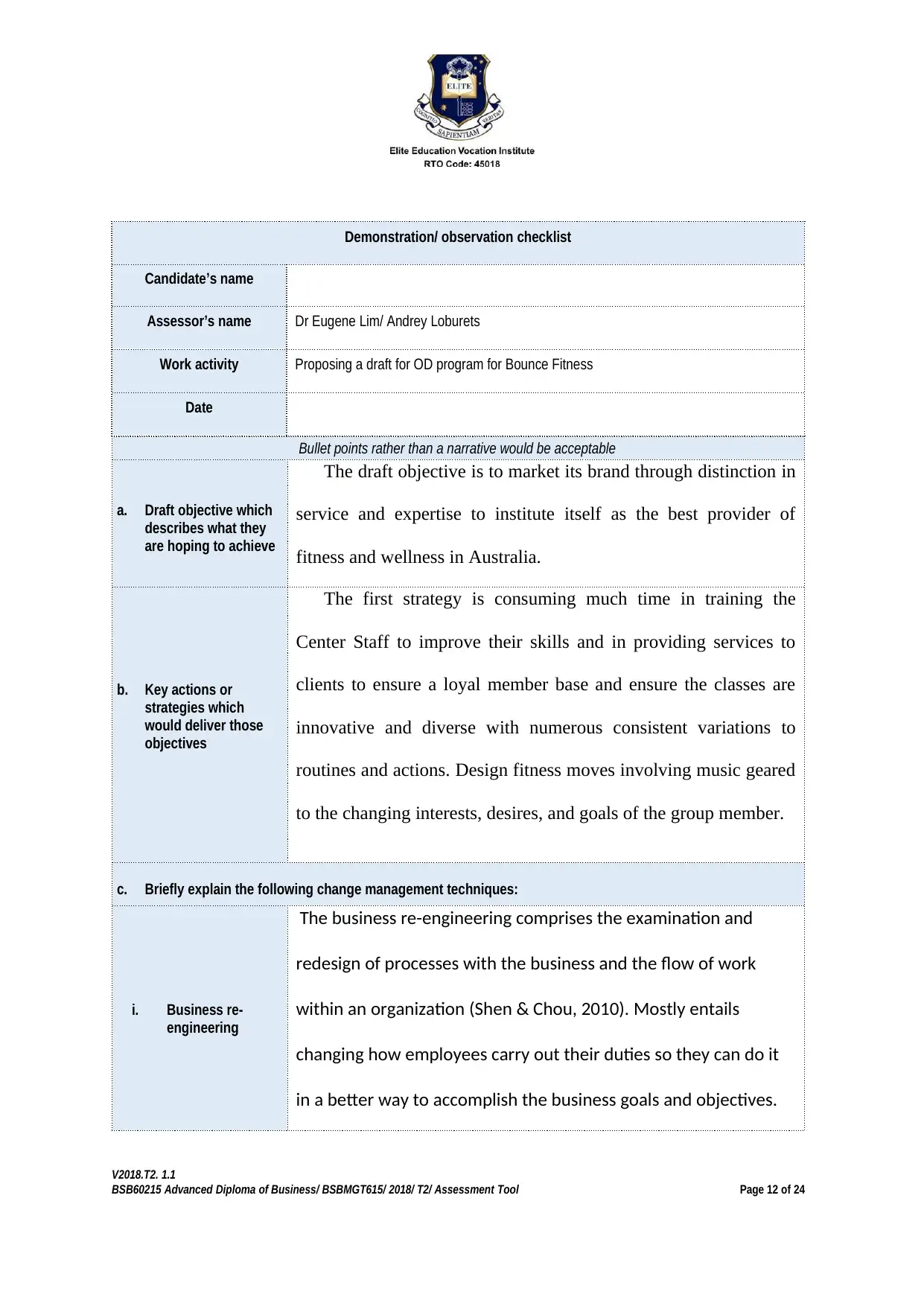
Demonstration/ observation checklist
Candidate’s name
Assessor’s name Dr Eugene Lim/ Andrey Loburets
Work activity Proposing a draft for OD program for Bounce Fitness
Date
Bullet points rather than a narrative would be acceptable
a. Draft objective which
describes what they
are hoping to achieve
The draft objective is to market its brand through distinction in
service and expertise to institute itself as the best provider of
fitness and wellness in Australia.
b. Key actions or
strategies which
would deliver those
objectives
The first strategy is consuming much time in training the
Center Staff to improve their skills and in providing services to
clients to ensure a loyal member base and ensure the classes are
innovative and diverse with numerous consistent variations to
routines and actions. Design fitness moves involving music geared
to the changing interests, desires, and goals of the group member.
c. Briefly explain the following change management techniques:
i. Business re-
engineering
The business re-engineering comprises the examination and
redesign of processes with the business and the flow of work
within an organization (Shen & Chou, 2010). Mostly entails
changing how employees carry out their duties so they can do it
in a better way to accomplish the business goals and objectives.
V2018.T2. 1.1
BSB60215 Advanced Diploma of Business/ BSBMGT615/ 2018/ T2/ Assessment Tool Page 12 of 24
Candidate’s name
Assessor’s name Dr Eugene Lim/ Andrey Loburets
Work activity Proposing a draft for OD program for Bounce Fitness
Date
Bullet points rather than a narrative would be acceptable
a. Draft objective which
describes what they
are hoping to achieve
The draft objective is to market its brand through distinction in
service and expertise to institute itself as the best provider of
fitness and wellness in Australia.
b. Key actions or
strategies which
would deliver those
objectives
The first strategy is consuming much time in training the
Center Staff to improve their skills and in providing services to
clients to ensure a loyal member base and ensure the classes are
innovative and diverse with numerous consistent variations to
routines and actions. Design fitness moves involving music geared
to the changing interests, desires, and goals of the group member.
c. Briefly explain the following change management techniques:
i. Business re-
engineering
The business re-engineering comprises the examination and
redesign of processes with the business and the flow of work
within an organization (Shen & Chou, 2010). Mostly entails
changing how employees carry out their duties so they can do it
in a better way to accomplish the business goals and objectives.
V2018.T2. 1.1
BSB60215 Advanced Diploma of Business/ BSBMGT615/ 2018/ T2/ Assessment Tool Page 12 of 24
⊘ This is a preview!⊘
Do you want full access?
Subscribe today to unlock all pages.

Trusted by 1+ million students worldwide
1 out of 23
Related Documents
Your All-in-One AI-Powered Toolkit for Academic Success.
+13062052269
info@desklib.com
Available 24*7 on WhatsApp / Email
![[object Object]](/_next/static/media/star-bottom.7253800d.svg)
Unlock your academic potential
Copyright © 2020–2025 A2Z Services. All Rights Reserved. Developed and managed by ZUCOL.





